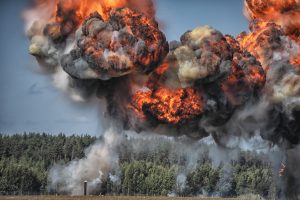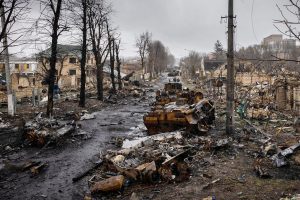Introduction
Armed conflict always causes destructive environmental damages especially when it damages hazardous industries and when chemical weapons are used. Almost one year since, the Russian Federal proceeded to a large-scale invasion of Ukraine, especially on 24 February 2022. Russia’s invasion of Ukraine caused a humanitarian crisis, destruction of civilian infrastructures including buildings, factories, and roads. Besides these, it also impacted the local environment by worsening people’s quality of life, destroying natural ecosystems and polluting the environment. With the explosion of each missile or projectile, it causes air, water and land pollution with toxic or chemical substances. The death and destruction of the environment, the Earth’s natural resources, and its inhabitants are almost always overlooked. Regarding all these, it is crucial to have a look at the environmental cost of this war. The aim of this article, based on a documentary approach, is to analyse the impact of the Ukraine war on the environment.
What is the effect of an armed conflict on the environment?
This question is important because the quality of life depends on the environment, while armed conflict, defined to include both interstate and intrastate military conflicts of at least 25 fatalities, occurs frequently throughout the world. While environmental quality is probably not a critical factor for leaders when national security is at stake, they may not ignore the effects of warfare on the environment if they are large (Rafael Reuveny, Andreea s. Mihalache-o’keef & Quan li 2014).
Direct conflict, nuclear weapons, military training, and military produced contaminants have an “overwhelmingly negative” effect on ecosystem structure and function through “dramatic habitat alteration, environmental pollution, and disturbance” which leads to population declines and biodiversity losses (Lawrence, et al, 2015).
Armed forces may destroy their own environment, or the environment of the other side, as a strategy to win the war. Both sides may also intensify the exploitation of their own resources or the commandeered resources of the other side, to support the war. Damages may also be indirect. For example, troop movement may degrade arable land and vegetation; fighting and arms production may increase pollution and waste; the provision of food and equipment for troops may intensify pressures on resources; norms in favour of environmental protection may deteriorate; and war refugees may dump waste and damage ecosystems in pursuit of food, land, and firewood (e.g., Dasgupta, 1995; McNeill, 2001).

Figure1: Stockholm Environment Institute

Figure2: GMA News Online
In Ukraine, the war is having a devastating impact on the natural environment. Russia’s forces have entered, or conducted military operations in, more than a third of the country’s protected natural areas (Anthes, E 2022), which are home to vibrant wetlands and a large swathe of intact steppe (Kricsfalusy, V. 2012). Bombing and weapons fire have deposited large quantities of heavy metals and chemicals on soils. A UNEP-cited report found that numerous coal mines in Ukraine’s Donbass region have been closed and flooded, likely causing seepage of methane gases and toxic heavy metals into groundwater (Velázquez, J 2022). Many parts of the country have large stocks of hazardous waste. If these are compromised during.
the war, this could have important water pollution ramifications, according to the World Wide Fund for Nature (WWF) Ukraine (Kekenadze, D. 2022). Importantly, the ongoing contamination of soil and groundwater will undermine Ukraine’s ability to produce stable crop yields, even after the war ends. Before the war, fluctuating weather conditions, particularly droughts and heat waves, already posed major challenges to agriculture in the country (Schierhorn, F all 2021).
The war itself is likely producing massive amounts of greenhouse gases, driving climate change. This is already taking a disproportionate toll on developing countries, especially on their agriculture (Dervis, K. & Mendelsohn, R 2008). While the magnitude of emissions is unclear, assessments of previous wars are alarming. For example, some 1.2 million tons of greenhouse gases were released as a result of the global war against IS terror that began in 2001 (Watson Institute 2019). Moreover, the war may well delay climate change action around the world, undermining the goal of limiting global warming to 1.5 degrees Celsius as per the Paris Agreement (Harvey, F. 2022).
The vast amounts of ammunition used in the conflict created water, air and soil pollution in an ecosystem already under stress from industrial pollution before the hostilities even began. Ukraine’s proliferation of heavy industrialisation meant hundreds of sites were especially vulnerable to conflict damage due to the presence of chemical, metallurgical and mining operations as well as atomic energy plants and nuclear waste dumps (Mathiese, 2022).
Conclusion
As a result, it is impossible to completely protect the environment from war without eliminating war itself. Sadly, the human race is not advanced enough to spread the beautiful idea of peace across the globe. Regarding the Ukraine war, the international community should have its eye on the respect of the rules on prohibitions regarding dams, dykes, and nuclear electrical generating stations, which are established under the Geneva Convention (s) and the Guidelines on the protection of the natural environment in armed conflict. Also, the international community should also get ready to make important efforts to support the post-war recovery of Ukraine, including restoration of the environment. It will also be crucial to help Ukraine ensure that the enormous task of rebuilding the country and its economy is not carried out at new environmental costs. Never forget, Peace can be another way to truly protect the environment from human conflict.
References
- Anthes, E., The New York Times (13 April 2022), https://nyti.ms/3I0b0b7
- Dasgupta, Partha S., 1995. ‘Population, Poverty and the Local Environment’, Scientific American: 272(2): 26-31.
- Dervis, K., UN Chronicle (n.d.), https://bit.ly/3b0pdbO
- Harvey, F., The Guardian (10 May 2022), https://bit.ly/3xX3haE.
- Kekenadze, D., Euronews (17 April 2022), https://bit.ly/3HqiMee.
- Kricsfalusy, V. (2012), https://bit.ly/3xVunyX.
- Lawrence, M. J., Stemberger, H. L., Zolderdo, A. J., Struthers, D. P., & Cooke, S. J. (2015). The effects of modern war and military activities on biodiversity and the environment. Environmental Reviews, 23(4), 443-460. https://cdnsciencepub.com/doi/10.1139/er-2015-0039
- Mathiesen, K., Guillot, L. & Zimmerman, A. (2022). Ukraine’s nuclear nightmare is only part of the war’s environmental horrors. Politico. https://www.politico.eu/article/ukraine-war-russia-nuclear-power-plant-map-zaporizhzhia-nightmare-environment/
- McNeill, John R., 2001. Something New Under the Sun: An Environmental History of the Twentieth-Century World. London: W. W. Norton.
- Mendelsohn, R. (2008), https://bit.ly/3b4PXrx.
- Rafael Reuveny, Andreea s. Mihalache-o’keef & Quan li; On the Effect of Warfare on the Environment 2014
- Schierhorn, F., Hoffman M., Gagalyuk, T., Ostapchuk, I., and Müller D. (2021), https://bit.ly/39q0kGg.
- The European Green Deal and the war in Ukraine (July 2022)
- Velázquez, J., Euronews (22 March 2022), https://bit.ly/3HtW9pt.
- Watson Institute of International and Public Affairs, Brown University (November 2019), https://bit.ly/3aY0bdj.

